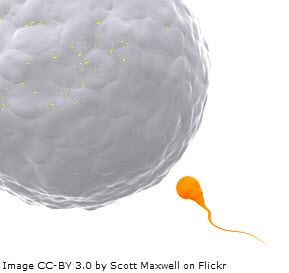Fertilization & blastocyst
 Students watch short videos illustrating internal and external fertilization before studying the processes which take place during fertilization. There is an activity to sort the steps into the right order followed by some flashcards. A final stepping stones activity also includes the early development of the embryo into a blastocyst is followed by implantation and the growth of the placenta.
Students watch short videos illustrating internal and external fertilization before studying the processes which take place during fertilization. There is an activity to sort the steps into the right order followed by some flashcards. A final stepping stones activity also includes the early development of the embryo into a blastocyst is followed by implantation and the growth of the placenta.
Lesson Description
Guiding Questions
- How can it be that from millions of sperm cells only one fertilizes the egg?
- How does a newly implanted blastocyst prevent the monthly period of the menstrual cycle?
Activity 1 - Processes of fertilization
Watch the explanations of reproduction in crabs and sea urchins as examples of external reproduction in this short video from David Attenborough. It is worth watching about five minute up to the herring spawning.
And internal fertilization with this short film of hedgehogs
And gorillas also use internal fertilization. They are of course also mammals like hedgehogs.
Answer the following questions about internal and external fertilization.
Questions
- How many egg cells are produced by the crabs, compared to the hedgehog and gorilla?
.................... - Give two advantages for animals using external fertilization in the sea.
..............................................................
.............................................................. - State a disadvantage of external fertilization
..................................................................................................................................................... - Describe an advantage of internal fertilization has over external fertilization.
..................................................................................................................................................... - Mammals and reptiles use internal fertilization, name two groups of animals which use external fertilization.
.....................................................................................................................................................
Click the eye icon to display model answers.
Some model answers
- How many egg cells are produced by the crabs, compared to the hedgehog and gorilla?
..Crabs produce many millions of eggs whereas a hedgehog will only produce a few. - Give two advantages for animals using external fertilization in the sea.
...Many more eggs can be produced...
...The sea can scatter the eggs over large distances (hundreds of miles).... - State a disadvantage of external fertilization
....Many of the eggs get eaten .......... - Describe an advantage of internal fertilization has over external fertilization.
.....The eggs are much less exposed to predators, and there is a much higher chance of fertilization and successful development of the fertilized egg............... - Mammals and reptiles use internal fertilization, name two groups of animals which use external fertilization.
... Fish, Sea urchins, Crabs, Clams....
Activity 2: The process of fertilization
The process of fertilization involves three stages,
- the acrosome reaction.
- fusion of sperm and egg membranes
- the cortical reaction
Watch this great short animation of fertilization - in sea urchins.
Study the following cards and:
Arrange the seven steps in the ![]() Seven steps of fertilization into the correct order
Seven steps of fertilization into the correct order
A model answer can be seen by clicking the eye icon
Steps in the process of fertilization
- Sperm are attracted to the secondary oocyte by a chemical signal.
- The first sperm to reach the zona pellucida binds and releases the contents of it’s acrosome
- Enzymes from the acrosome digest a path through the zona pellucida for the sperm to the plasma membrane
- The sperm’s plasma membrane fuses with the 2° oocyte’s plasma membrane which causes the cortical reaction.
- Cortical granules inside the oocyte fuse with the plasma membrane and release their contents.
- Enzymes from the cortical granules cause the zona pelucida to become hard preventing polyspermy.
- The two nuclei inside the fertilized egg cell fuse and the nucleus of the zygote.
Activity 3: Zygote development to blastocyst implantation
Once the egg has been fertilized it becomes a zygote and develops into an embryo
Zygote development summary
- The zygote (fertilized egg cell) continues dividing into 4 then 8 cells as it travels down the fallopian tube.
- A hollow ball of cells called a ‘blastocyst’ is formed and cells begin to differentiate.
- The zygote has become an embryo and next implants into the uterus lining (endometrium)
- If the embryo successfully implants it will keep growing and produce hCG hormone.
- hCG hormone causes the ovary to continue producing progesterone – pausing the menstrual cycle.
This short video shows the process.
Finally read the eleven steps in the ![]() fertilization to implantation stepping stones worksheet.
fertilization to implantation stepping stones worksheet.
Use the steps as prompts and students have to help each other to cross all the steps by remembering the details for each step as they cross the imaginary river.
Teachers notes
These three activities help students to learn the details of fertilization and the early growth of an embryo.
Each activity becomes increasingly complex.
The first questions from the videos in activity one could be done as a whole class and it aims to get students interested in the lesson.
PHSE Note: These videos use animal examples of sexual reproduction and the IB Guide doesn't mention the personal health aspects of human relationships or the responsibilities of young people to respect each other. If you would like to include something in your lesson to address issues about personal health choices and relationships, this video is a great opening which could lead to a discussion about respect and responsibilities in relationships.
The second activity focuses on the details of fertilization.
There are some really good extra video clips on fertilization in the widget below.
A possible data analysis question could be analysis of HCG levels linked to early detection of pregnancy and an implanted blastocyst.
In a HL class, this would be a good place to complete the SL topic 6 understandings about IVF.

 IB Docs (2) Team
IB Docs (2) Team
